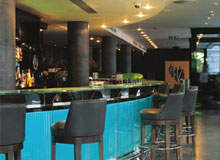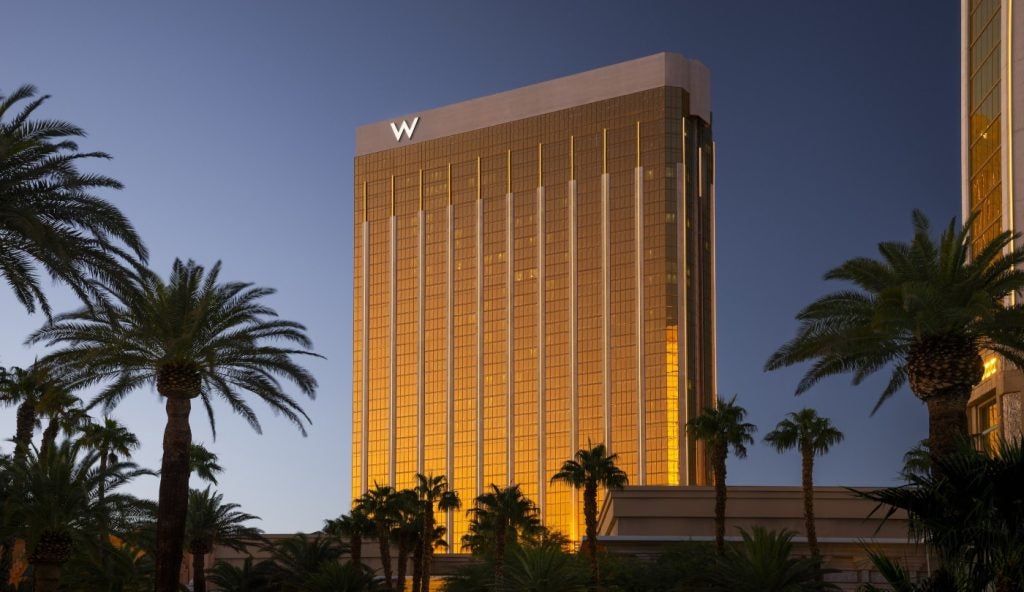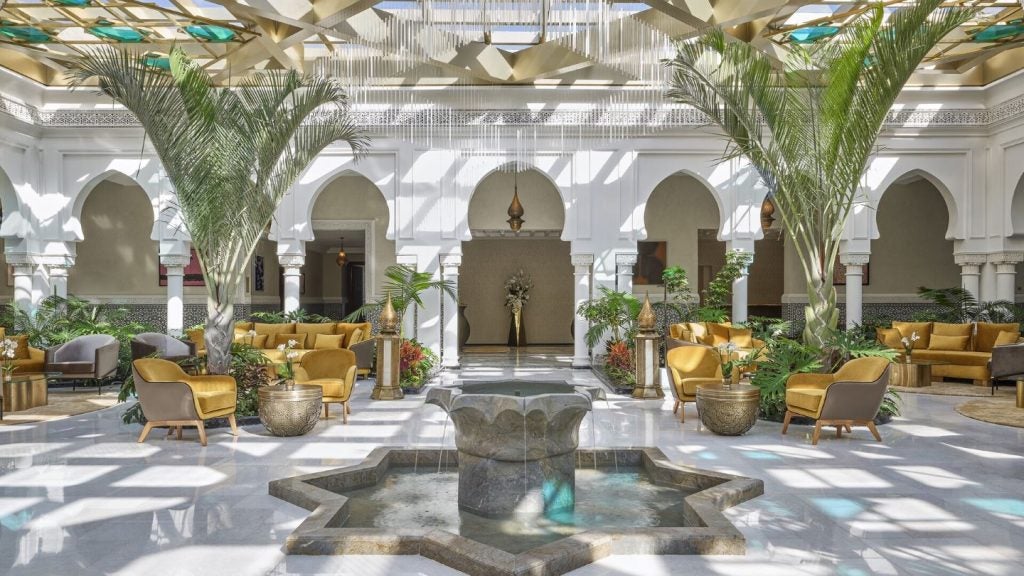
As Charles Oak describes the sight that met him two years ago, it is difficult to believe that he is talking about the same building. “The place looked like a relic from the 1970s,” remembers the May Fair Hotel’s general manager.
“It was in desperate need of a complete overhaul. I look at what we have created as a new hotel – it’s difficult to think anything else.”
It certainly is. £75m has been spent restoring London’s May Fair Hotel and after seeing the results, the term ‘refurbishment’ seems an understatement. Bought by Radisson Edwardian in 2004, although operating as a standalone brand, this establishment was once synonymous with glamour and good times. Opened in 1927 by King George V, it fast became a haunt of the rich and famous – especially under the Danziger brothers, founders of Elstree Film Studios, who turned it into the epicentre of London’s party scene.
Following its 1960s heyday, the May Fair passed through the stewardship of the Grand Metropolitan and InterContinental hotel groups, gradually losing appeal as more contemporary offerings opened. Now, with work finally completed, there is a genuine belief that its former status can be restored.
“At the moment there is nothing quite like this,” claims Michael Attenborough, head of design at Radisson since 1999. “We have a totally new interpretation of the large, luxury hotel.” Attenborough was hands-on throughout. “I was here every day for three years,” he begins. “There was no brief exactly. We just looked at what was needed and proceeded from there.”
Life was made easier by the fact that InterContinental had acquired planning permission for extensive works prior to selling up. The project has seen every room altered, a new wing constructed, a floor added to an existing wing, the theatre moved, a state-of-the-art spa installed, grand rooms created and vacant areas opened up.
How well do you really know your competitors?
Access the most comprehensive Company Profiles on the market, powered by GlobalData. Save hours of research. Gain competitive edge.

Thank you!
Your download email will arrive shortly
Not ready to buy yet? Download a free sample
We are confident about the unique quality of our Company Profiles. However, we want you to make the most beneficial decision for your business, so we offer a free sample that you can download by submitting the below form
By GlobalDataLUXURY WITHOUT PRETENSION
The philosophy underpinning these changes is what Radisson calls “luxury without pretension” – an approach Oak believes sets his hotel apart from other five-star destinations. “Luxury hotels have traditionally strived for a feeling of grandeur that generates an atmosphere of excessive formality and distance,” he begins. “But the white glove era is over; people have become far savvier.”
Attenborough agrees: “The concept of luxury has become so difficult to define. It is now available to the masses. The elite are looking for what nobody else has got and we must stay ahead of the game.”
By resisting this antiquated notion of the grand hotel, the May Fair has resolutely dragged itself into the 21st century. “What I have tried to create is a luxury that is exclusive without being excluding,” explains Attenborough. “This is the boutique experience on a grand scale.”
The general tone is one of uncluttered calm with individual ornaments and objets d’art, predominantly Oriental in theme, gracing public and private areas. Such serenity belies the fact that this is a central London establishment with 406 rooms.
INDIVIDUAL STYLE
At no point does one sense the identikit environment so often found within a large franchise. The hotel’s 235 ‘Superior’ rooms are fitted with handmade wool carpets, leather beds, Bang and Olufsen television sets, Sicilian marble bathrooms and furniture from Italian designer Cattelan.
The 142 Deluxe rooms are similar in design, with the added bonus of a seating area and designer chaise longue, a separate power shower and a walk-in wardrobe. The eight studios offer an open-plan lounge, digital entertainment system and deluxe bathroom. All are extremely stylish without being in the least bit fussy or overbearing.
However, the real innovations come into play a little further up the scale. The 11 Al Fresco rooms boast external decking, individual ornamental gardens with outdoor television and private dining facilities.
“We believe this is something completely new in London,” claims Attenborough. “There was the unique opportunity to design part of the hotel from scratch and, like all good ideas, it just seemed the obvious thing to do.”
The Al Fresco rooms offer a great example of his desire to create ‘luxury that makes a difference’. “It isn’t about a better grade of shampoo in the bathroom,” he explains. “It’s about being different and offering something that just isn’t available anywhere else.”
This attitude is further emphasised throughout the May Fair’s ten Signature suites. Whether it is the warmth of the Amber suite, decorated in burnt orange and rich tones of brown, or the rather more forceful Schiaparelli, a ritzy explosion of hot pink each space is completely unique and screams individuality.
REINVENTING LUXURY
Again, Attenborough has looked to update the concept of comfort and elegance practised at a typical five-star establishment. “We’ve taken a different view,” he says, “using new materials as well as old, new designs as well as accepted concepts of space. There’s no stuffy old chintz, but there might be gold leaf, marble, leather, or a combination of all three.” The effects are certainly startling, but what one is most struck by is how large these spaces feel, particularly for a central London destination.
There is plenty of innovation elsewhere. The May Fair Bar was one of the first renovated areas to go live. “It is probably my favourite feature of the entire project,” Oak says. “With no marketing or PR, 80% of the bar’s custom is external. We just opened up the windows and allowed those passing by to see what had been done. The fact that it has sold itself so successfully is testament to the quality of design.”
The space is certainly striking, with a hipper, younger feel than one might expect from a bar in a five-star hotel. Features such as slate-grey flooring, recessed windows, purple banquettes and a modern fireplace successfully fuse elegance with fun.
The hotel’s restaurant, Amba Bar & Grill, has a rather more prominent colour scheme – predominantly black, orange and amber – but is warm and comfortable rather than garish, with black faux crocodile skin, alma leather painted in tan and orange stripes, large domed pendant lights, gold leaf and orange faux snakeskin.
The transformation goes beyond sleeping, eating and drinking. The May Fair’s business wing boasts 11 interlinked rooms with capacities of six to 120 people. There is a videoconference suite and the latest in communication technology throughout.
With 201 seats, the May Fair Theatre is the largest private cinema in London and its proceedings can be transmitted to other meeting rooms and even bedrooms. Furthermore, its Audience Response System has been certified to provide data at shareholder meetings. Purpose-built from scratch, the theatre gives the May Fair a unique attraction to corporate clients.
OPULENCE REDEFINED
The jewel in the crown, however, must be the Crystal Room. The largest of the hotel’s function rooms, it can seat 180 for dinner or 250 for theatre-style presentations. “Our aim was to create London’s most beautiful room and I think we’ve done just that,” says Attenborough. He cites the Crystal and the smaller Danziger development as his proudest achievements.
“It is very difficult to design contemporary looking conference halls or ballrooms, but these have been a complete success,” he says. The Crystal Room pays homage to the hotel’s 1920s heritage. A retro shargreen panelling effect has been created, without the use of sharkskin, and the Oriental motif has been retained through inlaid red and black Japanese symbols – wood with a gold-coloured finish provides the backdrop material.
The room’s centrepiece is a 6mx3m Baccarat chandelier. Valued at over £1m, it is the largest-ever commercial commission from the Parisian design house and it looks remarkable.
Attenborough finds it peculiar that, although he took his inspiration for the room from the past, the result is very different indeed. “The room looks discreetly futuristic if anything,” he says. “There is nothing old-fashioned about it. Perhaps timeless is the best word.”
TIMELESS CHARM
Timelessness has been an important touchstone throughout the design process. “You don’t want to look new for the sake of it,” says Attenborough, “but neither does one want to look old fashioned. You need a look that works.”
Oak agrees. “The hotel is now wonderful, beautiful!” he exclaims. “Fresh but comfortable, simple but not painfully contemporary, glamorous but not intimidatingly so – it will still have that effect in ten or 20 years’ time. When we started the May Fair project, our aim was to be able to claim we were one of the leading hotels in the most vibrant city in Europe. We believe we’ve succeeded.” And not a 1970s relic in sight.







